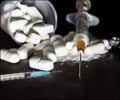Abnormalities in the cortex, the outer surface of the brain, among cocaine addicts that seem to correlate with dysfunction
Abnormalities in the cortex, the outer surface of the brain, among cocaine addicts that seem to correlate with dysfunction in areas responsible for attention and for reward-based decision-making have been uncovered by experts at Massachusetts General Hospital (MGH).
Writing about their brain imaging study in the journal Neuron, the researchers said that though some of the abnormalities might reflect an inborn vulnerability to drug use, others appeared to be the result of long-term cocaine exposure."These data point to a mixture of both drug effects and predisposition underlying the structural alterations we observed," said Dr. Hans Breiter, principal investigator of the Phenotype Genotype Project in Addiction and Mood Disorder in the MGH Departments of Radiology and Psychiatry.
"They also suggest that a key feature of addiction ? reduction in the range of activities in which addicts participate ? has a neural signature in the form of reduced cortical thickness in frontal regions of the brain," the researcher added.
During the study, magnetic resonance imaging investigations were conducted on 20 cocaine addicts and 20 carefully matched control participants to determine variations in cortical thickness.
The researchers found that, compared to their healthy counterparts, cocaine addicts had significantly less overall cortical volume, particularly in areas regulating reward function and involved with decision-making.
They said that the marked cortical thinness of areas involved in reward regulation and attention was not compensated by increases in other areas.
Advertisement
Throughout the brain, cocaine addicts had much less variation in cortical thickness than did controls, the researchers said.
Advertisement
Right- and left-side differences in the brain are important for many behaviours, and when they are altered, there is usually a genetic cause.
In contrast, another brain region involved with the regulation of reward ? the cingulate ? had cortical thickness measures that were related to the length of cocaine exposure but not to how long participants used nicotine or alcohol, implying that cocaine itself caused that difference.
Based on their observations, the researchers came to the conclusion that addiction-associated cortical thickness abnormalities may reflect both drug use and a pre-existing inclination to abuse drugs.
"The severity of these cortical alterations point to the potential importance of prevention efforts to keep susceptible individuals from beginning to use cocaine," Breiter says.
"Next we need to see if these findings are limited to cocaine users by testing larger groups of participants with different addictions and with commonly accompanying diagnoses like depression," the researcher adds.
Source-ANI
RAS/L













